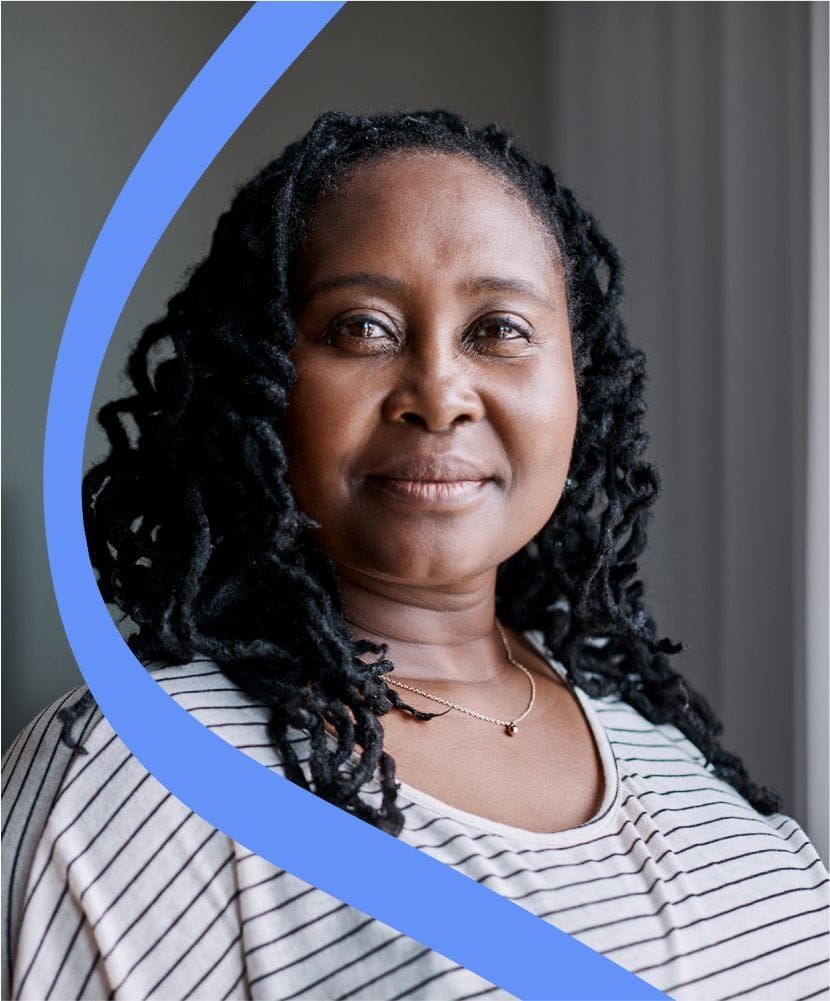What is BED?
Binge eating disorder (BED) is the most common eating disorder in the US. People with BED engage in repeated episodes of binge eating, or eating a large amount of food quickly while feeling out of control. Unlike bulimia, people with BED don’t throw up or engage in other purging behaviors after binging.
Binge eating disorder is not a choice or a lack of willpower. BED, like all eating disorders, has complex neurological and biological underpinnings, which is why we refer to it as a brain disorder. Social and environmental influences—like social media, family dynamics, and diet culture—can play a role, but they’re never the one “cause” (nor is anything else). BED, and all eating disorders, emerge out of a perfect storm of different factors.
BED has serious short- and long-term health consequences, but lasting recovery is possible with the right treatment.
Skip to a section
Signs and symptoms of binge eating disorder
Many people brush off the symptoms of binge eating disorder as not having enough “discipline” or “willpower.” This mentality ignores the fact that BED is a serious mental health condition that requires professional treatment.
Binge eating disorder can have significant negative effects on physical, mental, and emotional health, as well as greatly reduce quality of life. Learning to recognize the symptoms of BED—whether it’s in yourself or a loved one—is the first step toward getting the help necessary to recover.
- Weight changes, both up and down
- Lack of energy
- Stomach cramps or other gastrointestinal complaints, like constipation or acid reflux
- Thinning or loss of hair
Concerned you or a loved one might have binge eating disorder?
Bradycardia
Though BED is more common among people in large bodies, it affects people of all body sizes
The binge-restrict cycle
While they may seem like polar opposites from one another, binge eating and restrictive eating are two sides of the same coin. These behaviors often go hand-in-hand, with one fueling the other, in a pattern known as the binge-restrict cycle. The binge-restrict cycle is common and even normalized in our society (think about “saving up” calories for a big meal), but when it happens consistently, it can lead to an eating disorder.
What is bingeing?
A binge is when a person eats an objectively large amount of food in a short amount of time. Eating an extra slice of cake or going back for a third serving of pasta isn’t a binge—binges are distinct psychological events with specific characteristics.
Someone who’s engaging in a binge may feel like they’re unable to control how much they’re eating, and even have the sense that they’re outside their body while the binge is occurring. During a binge, a person typically continues to eat after they feel full, often to the point of extreme physical discomfort. Episodes of binge eating are almost always followed by intense feelings of shame or guilt and significant emotional distress.According to the Diagnostic and Statistical Manual of Mental Disorders, 5th edition (DSM-5), binge eating episodes are defined by two things²:
Within a 2-hour period, eating an amount of food that is definitely larger than most people would eat under similar circumstances
Feeling a lack of control over eating during the episode
Episodes of binge eating are also associated with other characteristics, including:
- Eating much more rapidly than normal
- Eating until feeling uncomfortably full
- Eating large amounts of food when not feeling physically hungry
- Eating alone because of being embarrassed by how much one is eating
- Feeling disgusted with oneself, depressed, or very guilty after overeating
How the cycle works
The binge-restrict cycle refers to periods of restricted eating followed by episodes of binge eating. Restriction is when you ignore your body’s hunger cues and eat very little, or nothing at all. A binge is when you eat an objectively large amount of food in a short span of time, often past the point of fullness and with a sense of not having control.
The binge-restrict cycle is a natural consequence of not listening to your body’s needs. When you restrict food—either by not eating, eating very little, or not allowing yourself of the foods you really want—you deprive your body of the nutrients and energy it requires to function. Your body then tries to communicate to you that it needs nourishment. One of the ways it does this is by producing a hormone called ghrelin, known as the “hunger hormone,” which stimulates your appetite. As you continue to restrict, more ghrelin is produced, causing your hunger to grow to a point where it takes the wheel. When you look at it this way, binge eating is a natural evolutionary adaptation: your body thinks you’re starving, and so when it finally gets food, it tries to consume as much as it can.
But it’s not just that binges tend to inevitably follow periods of restriction; restriction can also be a common response to a binge. That’s because binges are almost always followed by intense feelings of guilt and shame (which can be compounded by diet culture messages that tell us that restriction is an accomplishment and eating is a failure), and these feelings can lead to more restriction. The restriction can serve to “make up for” the food eaten during the binge, or even as a self-imposed punishment for binge eating. Either way, the cycle continues.
Though the binge-restrict cycle most commonly shows up in binge eating disorder and bulimia, it’s also present in some forms of OSFED, and the anorexia binge-purge subtype.

When you look at it this way, binge eating is a natural evolutionary adaptation: your body thinks you’re starving, and so when it finally gets food, it tries to consume as much as it can.
The 4 stages of the binge-restrict cycle
There are four stages of the binge-restrict cycle. They all exist in relation to one another, with each stage fueling the one that follows and making it nearly impossible for you to establish normal, healthy eating habits without help.
Restriction
You restrict your food intake, which can take the form of fasting, skipping meals, avoiding certain foods or entire food groups, or eating much less than your body needs.
Craving
The restriction triggers intense cravings or extreme hunger.
Bingeing
Your hunger becomes too much to ignore, and you eat an excessive amount of food in a short period of time. This is your body’s attempt to make up for the earlier restriction.
Guilt
Once the binge is over, you experience intense feelings of guilt, shame, and other hard emotions. Those emotions then lead you to restrict yet again.
Risks and complications of BEDWhen left untreated, BED can have a serious negative impact on physical health, mental health, and overall quality of life.
Physical health risks of BED
- Increased risk for diabetes, high blood pressure, high cholesterol, and some kinds of cancer
- Gastrointestinal issues, like bloating, cramping, nausea, vomiting, or constipation
- Acid reflux
- Lethargy
- Gallbladder disease
- Arthritis
- Insulin resistance
- Sleep apnea
- Musculoskeletal problems
Mental health risks of BED
- Increased risk for psychiatric illnesses, particularly depression, anxiety and substance use disorder
- Low self-esteem
- Social withdrawal and isolation that interferes with interpersonal relationships
- Decreased productivity and motivation at work, school, or home
3%
BED is the most common eating disorder in the US, affecting roughly 3% of Americans during their life.³Binge eating disorder treatment
Stereotypes, stigma, and the pressures of diet culture can make people affected by binge eating disorder feel like they should be able to overcome their behaviors through “willpower” and “discipline.” They may try, again and again, to “just stop” their binge eating behaviors, then feel shame, guilt, and low self-worth when they binge again. But this isn’t a failure: it’s the natural result of trying to treat a serious mental illness without the right support.
Just like any other eating disorder, binge eating disorder needs to be treated with multidisciplinary, evidence-based care that addresses all the aspects of the disease. The goals of binge eating disorder treatment are similar to the goals of treatment for other eating disorders: stopping disordered behaviors (in this case, binge eating), establishing a healthier relationship with food and body, and developing coping techniques to replace disordered behaviors.
As with treatment for anorexia and bulimia, the first step toward achieving those goals is to address the nutritional and behavioral aspects of the disorder. In the case of BED, this doesn’t just mean stopping binges (though that’s a big part of it) it also means eating regularly throughout the day. Because binges often occur after a period of restriction, eating three meals and snacks throughout the day is a key part of stopping the binge behavior.There are many different potential treatment settings and programs for binge eating disorder:
Inpatient hospitalization
Usually a short-term treatment reserved for those experiencing medical instability
Residential treatment
Patients stay at the treatment facility 24 hours a day, with round-the-clock supervision
Partial hospitalization program (PHP)
Patients attend treatment for most of the day, but return home to sleep
Intensive outpatient program (IOP)
Patients attend treatment for several hours a day, several times a week
Virtual treatment
There are many different types of virtual treatment for BED. Depending on the program, patients will have different levels of support and involvement. Research has shown that virtual eating disorder treatment is as effective as in-person care.
Binge eating disorder doesn't just go away
It's not feasible to treat BED on your own. If you’re struggling with binge eating, we recommend getting a professional consultation by your healthcare provider or an eating disorder expert as soon as you can.
What to expect from BED treatment at Equip
At Equip, we treat patients of all ages and acuity levels who are affected by binge eating disorder. The specifics of treatment are tailored to each patient’s unique needs, challenges, and life circumstances, but all Equip treatment includes certain components, like nutritional support, therapy, and a dedicated multidisciplinary care team.
Our care teams supports patients with the following services throughout the recovery process.
Your therapist will help you address the emotional and psychological factors that may be contributing to disordered behaviorals, as well as identify triggers and develop healthy coping strategies. They’ll also help you work through any co-occurring conditions, like anxiety or depression.
All Equip therapists are licensed practitioners who have specialized experience and training in eating disorders.
Common questions about binge eating disorder
Yes. BED isn’t a lack of willpower, it’s a diagnosable eating disorder that is completely treatable with the right, professional care. The earlier you get support, the easier it is to get ahead of the condition and recover, so don’t hesitate to reach out if you’re concerned.
One of the most common concerns patients have at the start of eating disorder treatment is wanting to lose weight or the fear of gaining it. Weight loss is never a primary goal of treatment, but some patients end up losing weight when their nutrition becomes stabilized and they stop certain disordered behaviors.
Proven results for ARFID patients
After completing treatment
improve to subclinical levels of eating disorder symptoms
meet their weight goals
Our patients are getting better
After the first 8 weeks of treatment, Equip patients are well on their way to recovery
1lb
Average weekly weight gain for those who need it
8 in 10
Patients report a decrease in eating disorder behaviors
74%
Of patients report improvements with depression or anxiety



Concerned? Learning more is a great first step.
Get resources related to BED and other eating disorders delivered to your inbox.
Dive DeeperLearn about the nuances of eating disorders, treatment, life in recovery, and more on our blog.
References
- National Institute of Mental Health. (2020). Definition & Facts for Binge Eating Disorder. U.S. Department of Health and Human Services, National Institutes of Health. Retrieved November 21, 2024, from https://www.niddk.nih.gov/
- Berkman ND, Brownley KA, Peat CM, et al. Management and Outcomes of Binge-Eating Disorder [Internet]. Rockville (MD): Agency for Healthcare Research and Quality (US); 2015 Dec. (Comparative Effectiveness Reviews, No. 160.) Table 1, DSM-IV and DSM-5 diagnostic criteria for binge-eating disorder. Available from: https://www.ncbi.nlm.nih.gov/books/NBK338301/table/introduction.t1/
- Kessler, Ronald C et al. “The prevalence and correlates of binge eating disorder in the World Health Organization World Mental Health Surveys.” Biological psychiatry vol. 73,9 (2013): 904-14. doi:10.1016/j.biopsych.2012.11.020
Privacy PolicyNotice of Privacy PracticesSecurity PolicyTerms & ConditionsGood Faith EstimateYour Privacy Choices
All names, likenesses, and identifying information have been changed in accordance with privacy laws. Images are of models, not actual patients.
Your privacy is Equip's priority, we safeguard your health information with end-to-end data encryption and industry-leading secure cloud practices. Our platform is HIPAA-compliant and SOC2 certified, ensuring your data is always protected.






